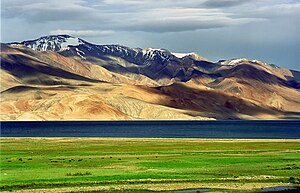Karakoram-West Tibetan Plateau alpine steppe
| Karakoram-West Tibetan Plateau alpine steppe | |
|---|---|

|
|
| Ecology | |
| Biome | Montane grasslands and shrublands |
| Borders | |
| Bird species | 172 |
| Mammal species | 45 |
| Geography | |
| Area | 143,300 km2 (55,300 sq mi) |
| Countries | India, China, Afghanistan and Pakistan |
| Conservation | |
| Habitat loss | 1.4065% |
| Protected | 18.28% |
The Karakoram-West Tibetan Plateau alpine steppe is a montane grasslands and shrublands ecoregion found in parts of Pakistan, China, Afghanistan, and India.
The Karakoram-West Tibetan Plateau alpine steppe is an area of high-elevation grasslands covering 143,300 square kilometres (55,300 sq mi). It is centered on the Karakoram Range, west of the Himalaya Range. It also includes nearby ranges, such as the Ladakh Range.
The mean annual precipitation in the ecoregion varies from 200 to 900 millimetres (7.9 to 35.4 in), 90 percent in the form of snow.
Most of this ecoregion consists of grasslands and herbaceous plants. Protected slopes and ravines contains Salix denticulata, Mertensia tibetica, Potentilla desertorum, Juniperus polycarpus, Polygonum viviparum, Berberis pachyacantha, Rosa webbiana, and Spiraea lycoides. Where vegetation ceases to grow, around 4,500 metres (14,800 ft), are found Delphinium cashmerianum, Glechoma tibetica, Silene longicarpophora, Potentilla fruticosa, and Nepeta spp.
Shrublands and woodlands are found in valley bottoms. These include Hippophae rhamnoides, Myricaria elegans, Salix viminalis, Capparis spinosa, Tribulus terrestris, Pegamum harmala, Sophora alopecuroides, and Lycium ruthenicum. A few remnant steppe forests of Juniperus macropoda and Juniperus indica are still found here.
...
Wikipedia
